The Rose Family: Market Gardeners, Funeral Directors, Justice of the Peace
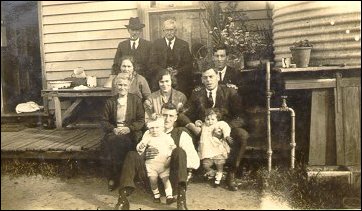
Members of the Rose family at 34 Glebe Avenue Cheltenham 1925.
When Walter George Thomas Rose died in 1963 at 72 year of age the Moorabbin News [1] reported that more than 600 people attended the funeral. Many represented local organisations where Wally, as he was known to all, was active; the Masonic Lodge, the Bowling Club, the Dad’s Association, the Cheltenham Elderly Citizen’s Club, the Cheltenham Mechanics Institute, the Cheltenham Chamber of Commerce and the Cheltenham football and cricket clubs. He was President of the cricket club for thirty years. “Dad was well known from Caulfield to Frankston both as a sportsman and funeral director,” his son Arthur explained. “We did funerals from Caulfield to Frankston and Dad played cricket in the Frankston Glenhuntly Cricket Association where he was involved for fifty years. But in addition he was just a good bloke. [2]
It was Wally’s grandfather Thomas Doubell Rose [3] who first came to the district from Essex in England to take up three acres of land in Cromer Road. There he commenced market gardening. Rate records of the Shire of Moorabbin show that from 1872 to 1882 he was farming an additional twenty two acres of land on Beach Road owned by Mrs Patterson. By 1886 he was listed as owning two properties in Cromer Road, one of two acres and the other of one, suggesting that his original three acres had been sub-divided. Both had four roomed houses built on them. Thomas Rose was noted by Sutherland as being the father of ten children, “six of whom have learned trades." [4] Thomas had married Susannah Male.
William Bruton recorded that Rose’s paddock next to the Well’s Estate was the venue for the local school’s picnic. [5] “The market drays - the only vehicles then in use - would be at the school, into which the youngsters would climb, or be lifted. With much hip-hurrahing, they would start off. No trains, trams, motor cars or bicycles in the way, those times, so they were soon unloaded in Rose’s paddock - a grand hilly, forest paddock - where swings were hanging from high limbs of high trees. There were cases of fruit, and such a quantity and variety of eatables, as would have satisfied the greediest grand Turk in Turkey. Everybody went to the picnic.”
As correspondent for the Beaumaris School Thomas Rose was immersed in the controversy about the creation of a new school in Charman Road. Three of his children, Jane, Moss and William were pupils at the school in Latrobe Street established by Frederick Meeres and later taken over by his younger brother, Walter. As the building at Latrobe Street was in a very dilapidated state and too small to accommodate all the pupils seeking admission, parents were requesting that a new school room be provided. Inspector Sasse from the Board of Education proposed that the new school be built in Balcombe Road but this was not acceptable to many parents. [6] Arising from this dissatisfaction Thomas Rose chaired a meeting of parents to consider the matter of site. Shortly after he became the correspondent for the Beaumaris school taking over from Henry Wells who resigned from the position. As correspondent or secretary of the school committee he presented to the Board the case for the amalgamation of the Beaumaris and Cheltenham schools and the construction of the new school on the government reserve next to the Cheltenham Cemetery. He also lobbied his local member of parliament asking him to use his influence to further their cause. After considerable effort on his part and by members of the school committee, on September 13, 1869 Rose was able to inform the Board that the new building was completed, ready for their inspection, and for occupancy by students and teacher. [7]
Three sons of Thomas Rose, Moss, William and Albert, attended the new school. Later in 1890, Shire Rate Records show a one acre property in Cromer Road was occupied by William Rose, a carpenter. Both William and brother Moss were carpenters and together they started a funeral business, Rose Bro’s, about 1883 but Moss did not stay long. He left it to pursue other interests. It was William Dubble Rose who persisted with the company that continued under the control of members of the Rose family until July 1, 1979.
William Dubble Rose was born in 1862 on the family property in Cromer Road, Beaumaris. He was given the name Dubble in error. Arthur, his grandson explained, “Strictly speaking his name was Doubell but when his birth was registered his name was spelt incorrectly and he became Dubble. From then on he was known as ‘Dub’ which caused a lot of fun because in those days the ‘Dub’ was the word used for the toilet.”
William married Emma Clara Chandler and they had two daughters and a son. [8] The son, Walter George Thomas Rose (Wal) joined his father in the family business which became known as W.D.Rose and Son. In 1898 William moved the funeral business to 34 Glebe Avenue, Cheltenham, a property that backed onto School No 84. Wal and his family also moved to Glebe Avenue to live opposite his parents, building a house which included a weatherboard section of the Rose house transported from Cromer Road. It was to this section that two brick rooms plus a veranda were added. [9]

Walter George Thomas Rose with his mother, Emma Clara Rose (Chandler) at Glebe Avenue c1925.
Arthur Rose recalled the days when the family funeral business operated from 34 Glebe Avenue. [10 “There were thirteen horses which they used to keep down in the Recreation Reserve between Weatherall Road and Glebe Avenue; where the football ground is today. Dad had an arrangement or agreement with the Council that he could leave the horses there over night and they would graze when they were not working. It was part of my job when I became old enough to go down in the morning before school and bring these horses up to the workshop yard so they could be made ready for the day. I would go down with a bridle and bang it on the tin fence. The horses would race from everywhere. I would put the bridle on a quiet old mare, climb up on the fence and hop onto her back. After opening the gate the horses would race up the side of the poppy farm into Glebe Avenue and down to the house on their own accord.”
“The horses were made ready for the day. They all had big three foot high black plumes on their heads. The harness was painted black. The hooves were painted black. They just shone as a black set of horses. There were four horses for the hearse and four for the coach and others were used to pull jinkers or other carts. The hearse was similar to those used today only it was a bigger. The body swung on springs like the Cobb and Co coaches. Not quite the same but a similar type of thing with a big glassed box. There were two back doors which opened to slide the coffin in on rollers. Usually the driver and conductor sat on the top at the front.”
Fairlie Taylor [11] recalled “the undertaker’s hearse drawn by horses at a snail’s pace - great black plumes waved from the top of the hearse. The undertaker, son of a pioneer, wore a long band of black crepe dangling from the back of his top hat. We all donned black armbands when one of our friends died, and every shop in the street was closely shuttered as the funeral passed by.”
Although involved in small ways prior to 1937 Arthur joined his father in the business after leaving school and his brother Laurie joined after the Second World War. “In those days we used to travel as far as Frankston quite regularly. We would hop in the car and go to the back blocks of Mordialloc and Chelsea to remove someone who died down there. Rather than employ one of the men after hours dad would take me. Obviously he didn’t have to pay me. It was family stuff and I was always interested in the business.”[12]
After completing a three year course at Caulfield Technical school learning carpentry and polishing Arthur found himself in 1937 making, polishing, trimming and attaching ornaments to coffins, and attending funerals. He recalled, “When we first started an inch of timber was worth a penny or two so if it didn’t need to be six foot three long you could save a few bob. Our sizes ranged for adults from five foot up to about six feet three. We occasionally made excess sizes but not often as there weren’t so many great tall people in those days. The shoulder width remained much the same. There were three widths - sixteen inches, eighteen inches and twenty two inches. The average person was 5 feet 6 inches.
“There were two major choices. The shaped ones were referred to as coffins and the oblong types as caskets. Generally the shaped ones were cheaper. But you would get to a stage in the range where some coffins would be dearer than the cheaper caskets. There were two basic colours, walnut and rosewood. At one stage there was a grey - fumed oak. Costs varied according to the materials used but ranged from two or three hundred dollars up to two or three thousand. The cheapest coffin was made of core board, five and eight ply - something of that nature. Then you got into solid timber. The ornaments added to cost, the handles, scrolls on lids, and the nature of materials used to trim inside the coffin all influenced the final price.
“People would contact us when a member of the family died. We would say, ‘We will be up to see you in half an hour or so’. We would then ring the doctor and advise him of the death, give him the name of the person, and ask him if would he issue a certificate and then arrange for him to see the body. As part of the paper work he had to see the deceased after death. The body would be taken back to the mortuary for preparation for the funeral. Sometimes this was done at the house with a visiting nurse laying out the body. The body was displayed if the family wanted it.”
“The funeral service could take place in the home, in a church, at the funeral parlour, or just at the cemetery. In those days (c1940) it was usual to have either a service at the house, the church or the parlour and then have a brief committal service at the grave side or crematorium. Going back in time it was the right thing to have the funeral leave from the house. That was normal. That created quite a bit of difficulty at times because some doors are situated in such a way that it is most difficult to get a coffin out and eventually we encouraged people to have a church service. It got to the stage where house funerals became less popular.
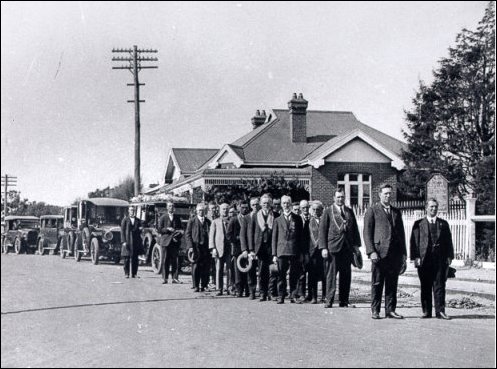
Funeral of Mr F. T. Le Page leaving Cheltenham Church of Christ. Walter George Rose standing at left of hearse, 1927.
“In 1927 the business was moved to 255 Charman Road, by the ramp leading to the Frankston side of the railway station. A double fronted two storey building was constructed there. The family also owned an irregular block of land between the back of the shops and the railway line. It also backed on to the Presbyterian Church. This land wasn’t used for a while but later a 60 x 30ft wooden building was erected there. A friend of my grandfather, Benny Matthews a funeral director in South Yarra, talked my grandfather into buying this building from the University of Melbourne. He had it pulled down, all the sections marked and brought down to Cheltenham and erected on the irregular piece of land. Eventually it became the garage, and workshop that had previously been located at Glebe Avenue.
“The parlour down in Charman Road was like a half way house. People, if they went into town, on the way home they would get out of the train walk down the ramp and into mum’s to have a cup of tea and say hello. In those days when we walked out the door we would say hello to everyone who went past and call them by name. It is different today. There were always five or ten people around. Dad and Mum were interested in cricket, football and bowls. It was nothing to have twenty people around our three quarter billiard table on a Saturday night to eat.” [13]
Both Wally and his wife Gladys were involved in community affairs. The local paper, reported in 1938 that “Walter George Thomas Rose has captained Cheltenham for the last 11 seasons (during which time he led three premiership sides, and he thinks he will lead another this year!). On five occasions he has won the bowling average trophy of the Association, and has won his club’s average for the past 12 seasons. He has been president of the Cheltenham club for the last seven years, and is a vice-president, member of the permit and umpire committee, and an auditor of the Frankston-Glenhuntly Cricket Association.” [14] He retired from the field in 1947 when his skill with the bat and ball was almost legendary. Although essentially a bowler he was also reputed to hold the record of the biggest hit out of the Cheltenham ground. His highest score was 142. Arthur said his father was an exceptionally good bowler. “He took about three steps up to the wicket, he was a medium fast bowler but he could put that ball on a threepenny bit anywhere he wanted to. I think he won more bowling averages than any other cricketer in the Frankston Glenhuntly Cricket Association. competition.” [15] In addition to his cricket Wally had played with the Cheltenham Football Club for 20 years being “one of the best full-backs in the game, and would have won fame in League company if his dad had not frowned on the proposal.”[16] He played his last game in 1929.
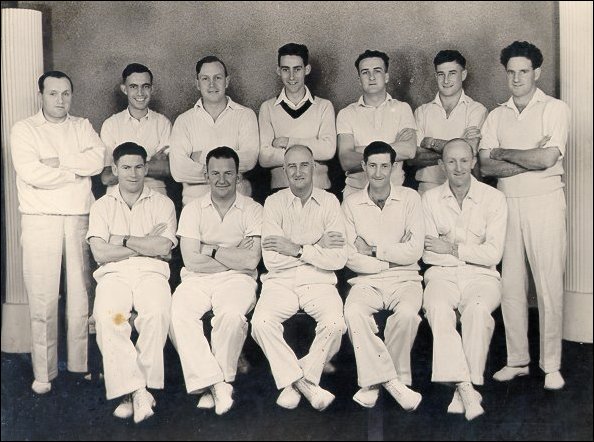
Cheltenham Cricket Team 1946 Runners-up in the Frankston Glenhuntly Cricket Association. 1945-46 Back Row: H. Tickle, W. Harman, D. Shields, J. Brymer, W. L. Rose, A. M. Rose, L. Marriott. Front Row: W. R. Todd, A. Robinson (Vice Captain), W. G. T. Rose (Captain), S. Marriott, T. Connor.
Fairlie Taylor wrote “I must tell you one lovely tale here about our undertaker - Wal. Rose - who was the hope of his side in cricket. He would be in the field in immaculate white togs when suddenly he would dash off to the dressing room and emerge a minute later in long black coat and top hat and go off to conduct a funeral. If his side was in difficulty, watches would come out and the men would be heard to say ‘he must be here soon!’ Then came the sound of galloping horses drawing a swaying hearse, and in a jiffy Wal would throw off his long black coat - his cricket togs were underneath - and go out to save his side.” [17] Although Arthur cannot confirm the actual details of Taylor’s story he agreed there were times when his father would come back from a funeral driving the hearse to where the team was playing, park by the side of a building and go in to change his clothes and come out in his creams to play cricket. “That often happened.” [18]
Wally had other interests besides his cricket and football. When younger and living in Glebe Avenue he kept a couple of ferrets. “He enjoyed rabbiting and shooting,” reported Arthur, “but it was his birds that I remember more than anything. At Charman Road he had two nice sized aviaries in the backyard where he bred a variety of birds. When he got too many he gave them away. He never made money out of them. We would go to the Prahran market in Chapel Street and if he saw a couple of finches that he didn’t have he was just as likely to buy them. I used to go out with him along Kingston Road where there was a lot of swamp ti-tree. There he would cut a number of stands to bring home and stand them against the brick wall so the birds could nest in it and pick it to bits. He spent a lot of time with his birds.” [19]
Gladys Elsie Elizabeth Wilkins married Wally Rose in 1916. She too became very active in community affairs. “For more than fifty years she was involved with a charitable group organised through the local council to help people in trouble, wives whose husbands had left them and kids who were out of shoes. People in need would come to mum and she would give them a voucher to go to the local butcher for meat or to the local grocer for groceries.” [20] For seven years she was the Secretary of the Cheltenham Ladies’ Bowling Club and an active member of the Cheltenham Presbyterian Church.
Arthur explained the family were Methodist but his mother was active in the Presbyterian Church. “We were a bit of a mixture. My grandfather was a Methodist, the greatest wowser, that you could ever find. We weren’t allowed to look sideways on Sunday. Sunday was a day of rest and that was it. The only thing you were allowed to do was go to work if someone died. That was a different story. But to pick up an axe or a tennis rack or cricket ball! No! That went through the family. Dad wasn’t as bad as my grandfather. He turned his eyes on a number of occasions but not my grandfather. Dad didn’t go to church. ‘I see enough of them during the week so I don’t need to go on Sunday’ was his view.”
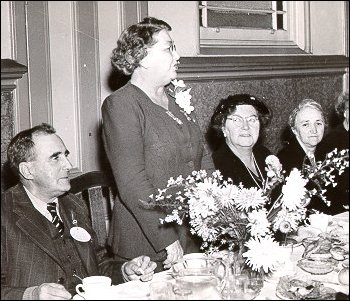
Gladys Rose as President of the Women’s Auxiliary of the Cheltenham Servicemen’s Fathers Association addresses a meeting. c1944.
Gladys Rose was the first woman in the district to be appointed a Justice of the Peace, a position in which she served for twenty five years. She was originally nominated as a JP by the Fathers’ Association, of which she was Victorian Ladies’ Auxiliary president. Most of her work involved signing affidavits and summonses. Her court appearances were strictly limited as she explained to a reporter from the Moorabbin News, ‘It was the first time I ever went to the courtrooms. As I was leaving, the men said they would never work with a woman again. I didn’t mind, anyway, because why should I sit on the court bench if I didn’t know anything about it?’.” [21] On her retirement she commented that she thought twenty five years as a Justice of the Peace was enough. “After all, you are not supposed to continue after the age of 72,” she informed the interviewer. At the time Gladys was 86.
The three children of Gladys and Walter were all interested in sport. Arthur and Laurie were keen competitors in local cricket and football while Jean was a very active and successful badminton player. Arthur Rose started his football career at the Cheltenham Primary School going on to play in 1936 with the Cheltenham Juniors. There he won the trophy for the best and fairest player in the Federal District League Juniors, scoring 28 votes. “The fact that his nearest opponent was only 12 votes indicated Arthur Rose’s brilliant form. He was then promoted to the Cheltenham seniors, and played the last three games of the season, scoring eight out of a possible nine votes for the League trophy.” [22]
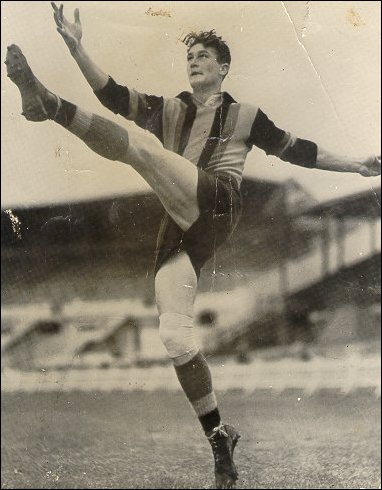
Arthur Rose training at with St Kilda Football Club at the Junction oval wearing a Cheltenham football jumper.
At the age of 17 he transferred to St Kilda, initially to play in the second eighteen but in the following season he had this first senior game when St Kilda played at Essendon. There, the Moorabbin News reported, “he flung himself into the game, and collided with an Essendon player near the goals. Although physically injured, he went back near the fence to take his free kick, and was mentally injured by the abuse of an irate lady spectator, who assaulted him with her umbrella.” After serving in the Australian army in the Middle East and New Guinea Arthur joined the Brighton Football Club but returned to the Cheltenham Club in 1949 as coach. [23]
Members of the Rose family have been important contributors to the sporting and community life of the district over four generations spanning 128 years.
Footnotes
- Moorabbin Standard News, November 20, 1963.
- Whitehead, G. Interview Arthur Rose, September 1999.
- Memorandum of Sale gives spelling of name as Thomas Double Rose.
- Sutherland, A., Victorian and Its Metropolis, 1888, page 742.
- Bruton, W., Local History: Carrum to Cheltenham, 1999, page 57.
- Education Department Correspondence.
- Education Department Correspondence.
- William and Emma Clara (nee Chandler) had three children, Vera Elizabeth Ruth Rose, Beatrice Clara Rose and Walter.
- George Thomas Rose.
- Whitehead, G. Interview Arthur Rose, September 1999.
- Whitehead, G. ibid.
- Taylor, Fairlie Memories of Early Cheltenham 1958 (Manuscript).
- Whitehead, G. Interview Arthur Rose, September 1999.
- Whitehead, G. ibid.
- Moorabbin News, 1938.
- Whitehead, G. op.cit.
- Moorabbin News 1938.
- Taylor, Fairlie Memories of early Cheltenham 1958 (Manuscript).
- Taylor, Fairlie ibid.
- Whitehead, G. Interview Arthur Rose, September 1999.
- Whitehead, G. ibid.
- Moorabbin News September 1979.
- Woolley, Ron, “Coach Arthur Rose has Brilliant Career” Moorabbin News, March 4, 1949.
- Woolley, Ron, “Cheltenham Coach for Brighton, Required for V.F.A. finals.” Moorabbin News August 24, 1949.
